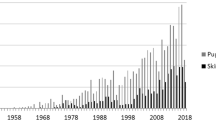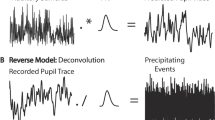Abstract
The guinea-pig is an attractive model for investigating gaze stabilization because it is suitable for in vitro and in vivo studies. However, few data are available on its oculomotor performance. We therefore investigated spontaneous eye movements, horizontal vestibulo-ocular (HVOR) and vestibulo-collic reflexes (HVCR) in the alert head-fixed guinea-pig using the magnetic search coil method. First the characteristics of the spontaneous saccades in the light were analysed. They occurred with a mean frequency of 4.6/min and with a mean amplitude and duration of 7.41±3.57 deg and 30.9±9.5 ms, respectively (n = 340). Saccadic duration and velocity were linearly related to the amplitude of the eye movement. The HVOR was studied in response to sinusoidal rotations (0.01 Hz to 2 Hz, peak head velocity of 40 deg/s) in the dark. Vestibular responses were linear at 0.5 and 0.05 Hz for peak head velocities between 40 and 80 deg/s. As in other species, the gain increased and the phase lead decreased with increasing frequencies. The number of fast phases per second increased with peak head velocity and with increasing frequencies from 0.01 to 0.5 Hz, with a plateau between 0.2 and 0.5 Hz. The HVOR time constant, when measured in response to velocity steps, was 7.0±1.5 s and the latency of the vestibular responses averaged 21±4 ms. Finally, the HVCR was assessed in unrestrained guinea-pigs subjected to horizontal sinusoidal rotation in the frequency range of 0.05–2 Hz. Exploratory behaviour was prevalent and there were few head stabilization episodes. However, when it occurred, the HVCR gain and phase were relatively flat over a frequency range from 0.1 to 2 Hz, reaching values close to 0.9 and 12 deg, respectively. In summary, the saccadic eye movements, the HVOR and the HVCR in the guinea-pig appear to be sufficiently similar to those of other vertebrates, including humans, to allow this species to be used as a model for studies of new pharmacological agents for vestibular disorders and post-lesional plasticity.
Similar content being viewed by others
References
Baarsma EA, Collewijn H (1974) Vestibulo-ocular and optokinetic reactions to rotation and their interaction in the rabbit. J Physiol (Lond) 238:603–625
Bahill AT, Clark MR, Stark L (1975) The main sequence: a tool for studying human eye movements. Math Biosci, 24:191–204
Baker R, Evinger C, McCrea RA (1981) Some thoughts about the three neurons in the vestibulo-ocular reflex. In: Cohen B (eds) Vestibular and oculomotor physiology: International Meeting of the Barany Society. Ann N Y Acad Sci 374: 171–188
Barnes GR (1979) Vestibulo-ocular function during coordinated head and eye movements to acquire visual targets. J Physiol (Lond) 287:127–147
Barnes GR, Eason RD (1988) Effects of visual and non-visual mechanisms on the vestibulo-ocular reflex during pseudo-random head movements in man. J Neurophysiol 395:383–400
Collewijn H (1977) Vestibulo-ocular and optokinetic reactions to rotation and their interactions in the rabbit. J Physiol (Lond) 238:603–625
Collewijn H, Winterson BJ, Van der Steen J (1980) Post-rotatory nystagmus and optokinetic after-nystagmus in the rabbit linear rather than exponential decay. Exp Brain Res 40:330–338
Curthoys IS (1982) The response of primary horizontal semicircular canal neurons in the rat and guinea-pig to angular acceleration. Exp Brain Res 47:286–294
Curthoys IS, Curthoys EJ, Blanks RHI, Markham CH (1975) The orientation of the semicircular canals in the guinea-pig. Acta Otolaryngol 80:197–205
Dieringer N, Precht W (1982) Compensatory head and eye movements in the frog and their contribution to stabilization of gaze. Exp Brain Res 47:394–406
Donaghy M (1980) The cat's vestibulo-ocular reflex. J Physiol (Lond) 300:337–351
Easter SS (1975) The time course of saccadic eye movements in goldfish. Vision Res 15:405–409
Evinger C, Fuchs AF (1978) Saccadic, smooth pursuit, and optokinetic eye movements of the trained cat. J Physiol (Lond) 285:209–229
Fetter M, Tweed D, Hermann W, Wohland-Braun B, Koenig E (1992) The influence of head position and head reorientation on the axis of eye rotation and the vestibular time constant during postrotatory nystagmus. Exp Brain Res 91:121–128
Fuchs AF (1967) Saccadic and smooth pursuit eye movements in the monkey. J Physiol (Lond) 191:609–631
Fuchs AF, Robinson DA (1966) A method for measuring horizontal and vertical eye movement chronically in the monkey. J Appl Physiol 21:1068–1070
Fuller JH (1981) Eye and head movements during vestibular stimulation in the alert rabbit. Brain Res 205:363–381
Fuller JH (1985) Eye and head movements in the pigmented rat. Vision Res 25:1121–1128
Furman JM, O' Leavy DP, Wolfe JW (1982) Dynamic range of the frequency response of the horizontal vestibulo-ocular reflex of the alert rhesus monkey. Acta Otolaryngol 93:81–91
Gresty MA (1975) Eye, head and body movements of the guinea-pig in response to optokinetic stimulation and sinusoidal oscillation in yaw. Pflügers Arch 353:201–214
Hardy O, Mirenowicz J (1991) Transient increase of contraversive saccade parameters following kainic acid injection in the periparabigeminal area of guinea-pig. Exp Brain Res 85:616–620
Hess BJM, Precht W, Reber A, Cazin L (1985) Horizontal optokinetic ocular nystagmus in the pigmented rat. Neuroscience 15:97–107
Hess BJM, Blanks RHI, Eannou J, Precht W (1989) Effects of kainic acid lesions of the nucleus reticularis tegmenti pontis on fast and slow phases of vestibulo-ocular and optokinetic reflexes in the pigmented rat. Exp Brain Res 74:63–70
Hughes A (1977) The topography of vision in mammals of contrasting life style: comparative optics and retinal organisation. In: Crescitelli F (eds) Handbook of Sensory Physiology, the visual system in vertebrates, vol 5. Springer, Berlin Heidelberg New York, pp 613–756
Jones GH, Milsum JH (1971) Frequency-response analysis of central vestibular unit activity resulting from rotational stimulation of the semicircular canals. J Physiol (Lond) 219:191–215
Lanman J, Bizzi E, Allum J (1978) The coordination of eye and head movements during smooth pursuit. Brain Res 153:39–53
Lestienne F, Vidal PP, Berthoz A (1984) Gaze-changing behaviour in head-restrained monkey. Exp Brain Res 53:349–356
Lisberger SG (1984) The latency of pathways containing the site of motor learning in the monkey vestibulo-ocular reflex. Science 225:74–76
Maas EF, Huebner WP, Seidman SH, Leigh RJ (1989) Behavior of human horizontal vestibulo-ocular reflex in response to high acceleration stimuli. Brain Res 499:153–156
McKinley PA, Peterson BW (1985) Voluntary modulation of the vestibulo-ocular reflex in humans and its relation to smooth pursuit. Exp Brain Res 60:454–464
Melvill Jones G (1964) Predominance of anticompensatory oculomotor response during rapid head rotation. Aerosp Med 35:965–968
Merwin WH, Wall C, Tomko DE (1989) The chinchilla's vestibuloocular reflex. Acta Otolaryngol (Stockh) 108:161–167
Mirenowicz J, Hardy O (1992) Characteristics of saccades induced by neck torsions: a re-examination in the normal guinea-pig. Brain Res 592:1–7
Paige GD (1989) Nonlinearity and asymmetry in the human vestibulo-ocular reflex. Acta Otolaryngol (Stockh) 108:1–8
Pettorossi VE, Mamonte F, Errico P, Ongini E, Dracchio F, Sabetta F (1986) Vestibulo-ocular reflex (VOR) in guinea-pigs. Acta Otolaryngol (Stockh) 101:378–388
Raphan T, Matsuo V, Cohen B (1979) Velocity storage in the vestibulo-ocular reflex arc (HVOR). Exp Brain Res 35:229–248
Robinson DA (1976) Adaptive gain control of vestibulo-ocular reflex by the cerebellum. J Neurophysiol 39:954–969
Sargent EW, Paige GD (1991) The primate vestibulo-ocular reflex during combined linear and angular head motion. Exp Brain Res 87:75–84
Serafin M, Khateb A, de Waele C, Vidal PP, Mühlethaler M (1992) Medial vestibular nucleus in the guinea-pig. NMDA induced oscillations. Exp Brain Res 88:187–192
Skavenski AA, Hansen RM, Steinmann RM, Winterson BJ (1979) Quality of retinal image stabilization during small natural and artificial body rotations in man. Vision Res 19:675–683
Smith PF, Curthoys IS (1988a) Neuronal activity in the contralateral medial vestibular nucleus of the guinea-pig following unilateral labyrinthectomy. Brain Res 444:295–307
Smith PF, Curthoys IS (1988b) Neuronal activity in the ipsilateral medial vestibular nucleus of the guinea-pig following unilateral labyrinthectomy. Brain Res 444:308–319
Smith PF, Curthoys IS (1989) Mechanisms of recovery following unilateral labyrinthectomy: a review. Brain Res Rev 14:155–180
Smith PF, Darlington C, Hubbard JI (1991) Evidence for inhibitory amino acid receptors on guinea-pig medial vestibular nucleus neurons in vitro. Neurosci Lett 121:244–246
Sugie N, Jones GM (1971) A model of eye movements induced by head rotation. IEEE Trans SMC 1:251–260
Tempia F, Dieringer N, Strata P (1991) Adaptation and habituation of the vestibulo-ocular reflex in intact and inferior olive-lesioned rats. Exp Brain Res 86:568–578
Vibert N, de Waele C, Escudero M, Vidal PP (1993) The horizontal vestibulo-ocular reflex in the hemilabyrinthectomized guinea-pig. Exp Brain Res 97:263–273
Vidal PP, Roucoux A, Berthoz A (1982) Horizontal eye position-related activity in neck muscles of the alert cat. Exp Brain Res 46:448–453
Vidal PP, Corvisier J, Berthoz A (1983) Eye and neck motor signals in periabducens reticular neurons of the alert cat. Exp Brain Res 53:16–28
de Waele C, Serafin M, Mühlethaler M, Vidal PP (1988). Vestibular compensation: an in vivo and in vitro study of second order vestibular neurons. Soc Neurosci Abstr 14, 137. 10
Winterson BJ, Collewijn H, Steinman RM (1979) Compensatory eye movements to miniature rotations in the rabbit: implications for retinal image stability. Vision Res 19:1155–1159
Yagi T, Ueno H (1988) Behavior of primary horizontal canal neurons in alert and anaesthetized guinea-pigs. Exp Neurology 101:356–365
Author information
Authors and Affiliations
Rights and permissions
About this article
Cite this article
Escudero, M., de Waele, C., Vibert, N. et al. Saccadic eye movements and the horizontal vestibulo-ocular and vestibulo-collic reflexes in the intact guinea-pig. Exp Brain Res 97, 254–262 (1993). https://doi.org/10.1007/BF00228694
Received:
Accepted:
Issue Date:
DOI: https://doi.org/10.1007/BF00228694




